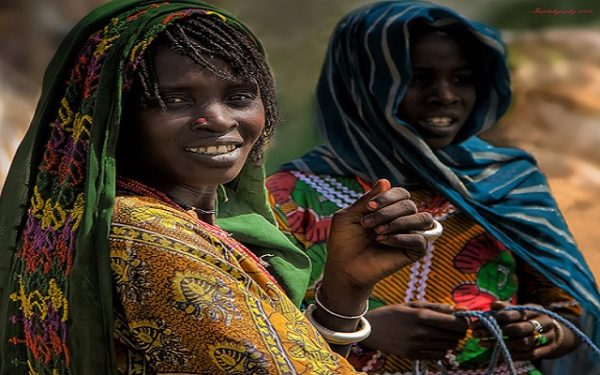The name Kanuri is from the combination of two Kanuri words; “Ka” meaning Stick and a word derived from the Arabic word NUR or “Nuri” meaning Light (Though in Kanuri itself Nur means light), thus, KA + NURI= KANURI. But this appellation was due to the fact that the Kanuri immigrants to Nigeria were mainly Pastoralists engaged in rearing of cattle and Sheep. A characteristic of the pastoralist is the stick; used in guiding the animal usually, of which the Kanuri were no exceptions
The Kanuri people (Kanouri, Kanowri, also Yerwa, Bare Bari and several subgroup names) are an African ethnic group living largely in the lands of the former Kanem and Bornu Empires in Niger, Nigeria and Cameroon. Those generally termed Kanuri include several subgroups and dialect groups, some of whom feel themselves distinct from the Kanuri. Most trace their origins to ruling lineages of the medieval Kanem-Bornu Empire, its client states or provinces. In contrast to neighboring Toubou or Zaghawa pastoralists, Kanuri groups have traditionally been sedentary, engaging in farming, fishing the Chad Basin, and engaged in trade and salt processing.
Kanuri: Inhabitants of the North Eastern Nigeria
The largest population of Kanuri reside in the northeast corner of Nigeria, where the ceremonial Emirate of Bornu traces direct descent from the Kanem-Bornu empire, founded sometime before 1000 CE. Some 3 million Kanuri speakers live in Nigeria, not including about 200,000 speakers of the Manga or Mangari dialect. The Nga people in Bauchi State trace their origins to a Kanuri diaspora.
In southeastern Niger, where they form the majority of the sedentary population, the Kanuri are commonly called Bare Bari (a Hausa name). The 400,000 Kanuri population in Niger includes the Manga or Mangari subgroup, numbering some 100,000 (1997) in the area east of Zinder, who regard themselves as distinct from the Bare Bari.
Kanuri speak varieties of Kanuri, one of the Nilo-Saharan languages. Divisions include the Manga, Tumari, and Bilma dialects of Central Kanuri and the more distinct Kanembu language.
Traditional structure of the Kanuris
Kanuri society is stratified into several distinct classes. The family of the ‘Shehu’; the political and religious head of all Kanuri, forms a royal lineage. Much pageantry continues to be connected with the court. Most Kanuri are in the class of commoners. Before the British came, there was also a class of slaves who could, nonetheless, rise to prominence in court. Kin groups are not as important among the Kanuri as they are among most other African peoples; the household of a rich, powerful, and noble individual becomes the central focus for many people. The Kanuri are polygynous. The typical household unit is the nuclear family of husband, wife, and children or the polygynous family living in a compound. Houses are of sun-dried mud bricks and may be square or round, with flat or thatched roofs, respectively.
Following the downfall of the Bornu Empire and the Scramble for Africa in the 19th century, the Kanuri were divided under the rule of the British, French and German Empires.
Despite the loss of the Kanuri-led state, the Shehu of Bornu continues as the head of the Bornu Emirate. This traditional Kanuri/Kanembu state maintains a ceremonial rule of the Kanuri people, based in Maiduguri, Borno State, Nigeria, but acknowledged by the 4 million Kanuri in neighboring countries. The Shehu (“Sheikh”) of Bornu draws his authority from a state founded before 1000 CE, the Kanem-Bornu Empire.
References
Featured image source: Connect Nigeria


